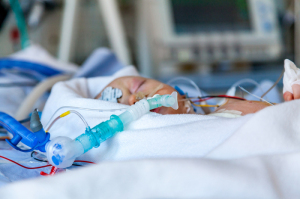Cardiac imaging during open heart surgery may save children's lives
by Lauren Dubinsky, Senior Reporter | December 21, 2016
Cardiology
Pediatrics

CHOP researchers hope research
will spread awareness
will spread awareness
Cardiac imaging can potentially save a child’s life during open heart surgery, according to a new study published in the Journal of Thoracic and Cardiovascular Surgery. It can detect serious residual holes in the heart that may occur when surgeons repair a heart defect, and allows them to close those holes in the same operation.
Those holes are called intramural ventricular septal defects and they are located between two chambers of the heart. These defects are different from other types of residual holes in that they can increase the risk of complications and mortality in children with heart disease.
Researchers at Children’s Hospital of Philadelphia evaluated 337 children who underwent surgery at the hospital for conotruncal defects from 2006 to 2013. That type of defect is an abnormality in the heart’s outflow tracts and it results in irregular blood circulation and potential health problems.


 Some cardiac surgeons repair conotruncal defects by sewing a patch from the ventricle to one of the outflows. In rare cases, a residual hole around the patch may allow blood to flow into the right ventricle, which is potentially life threatening.
Some cardiac surgeons repair conotruncal defects by sewing a patch from the ventricle to one of the outflows. In rare cases, a residual hole around the patch may allow blood to flow into the right ventricle, which is potentially life threatening.
The researchers compared the use of intraoperative transesophageal echocardiography, which was used during surgery, to transthoracic echocardiography, which was performed after surgery. Out of 337 patients, 34 were found to have intramural VSDs.
TTE and TEE identified 19 VSDs and 15 were identified by TTE only. They also found that TEE had 56 percent sensitivity, but 100 percent specificity in identifying intramural VSDs.
The researchers stated that the modest sensitivity suggests that many intramural defects are not detected in the operating room. But they also added that intraoperative TEE was able to spot most of the intramural defects that required further surgery.
"Unless you know where to look [with] TEE, this type of defect can be missed," Dr. Meryl S. Cohen, pediatric cardiologist at CHOP, told HCB News. "The study suggests ways to avoid missing this type of defect [as] some become larger after the surgery too."
Those holes are called intramural ventricular septal defects and they are located between two chambers of the heart. These defects are different from other types of residual holes in that they can increase the risk of complications and mortality in children with heart disease.
Researchers at Children’s Hospital of Philadelphia evaluated 337 children who underwent surgery at the hospital for conotruncal defects from 2006 to 2013. That type of defect is an abnormality in the heart’s outflow tracts and it results in irregular blood circulation and potential health problems.
Training and education based on your needs
Stay up to date with the latest training to fix, troubleshoot, and maintain your critical care devices. GE HealthCare offers multiple training formats to empower teams and expand knowledge, saving you time and money

The researchers compared the use of intraoperative transesophageal echocardiography, which was used during surgery, to transthoracic echocardiography, which was performed after surgery. Out of 337 patients, 34 were found to have intramural VSDs.
TTE and TEE identified 19 VSDs and 15 were identified by TTE only. They also found that TEE had 56 percent sensitivity, but 100 percent specificity in identifying intramural VSDs.
The researchers stated that the modest sensitivity suggests that many intramural defects are not detected in the operating room. But they also added that intraoperative TEE was able to spot most of the intramural defects that required further surgery.
"Unless you know where to look [with] TEE, this type of defect can be missed," Dr. Meryl S. Cohen, pediatric cardiologist at CHOP, told HCB News. "The study suggests ways to avoid missing this type of defect [as] some become larger after the surgery too."
You Must Be Logged In To Post A CommentRegisterRegistration is Free and Easy. Enjoy the benefits of The World's Leading New & Used Medical Equipment Marketplace. Register Now! |
|










